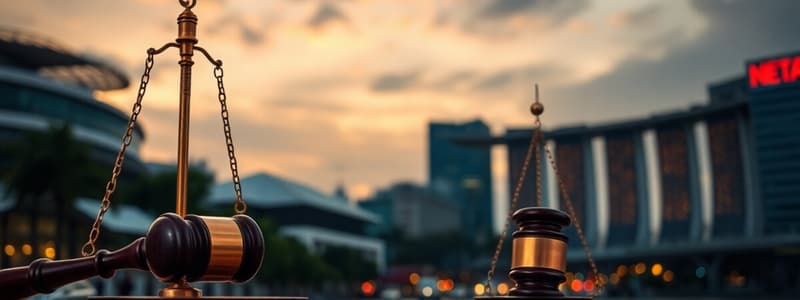Podcast
Questions and Answers
What is the potential financial penalty for infringing parties under the Competition Act?
What is the potential financial penalty for infringing parties under the Competition Act?
- Up to 10% of the annual turnover attributable to Singapore, up to a maximum of three years (correct)
- Up to 15% of the annual turnover attributable to Singapore
- A fixed penalty of $1 million regardless of turnover
- Up to 10% of the annual turnover attributable to Singapore, up to a maximum of five years
Which of the following methods does the CCCS use to detect anti-competitive behavior?
Which of the following methods does the CCCS use to detect anti-competitive behavior?
- Surveillance through proprietary digital scanning systems (correct)
- Public surveys to gather consumer insights on competition
- Mandatory yearly reports from all businesses about market behavior
- Analyzing social media activities of businesses for anti-competitive trends
In which situation might the CCCS keep an investigation confidential?
In which situation might the CCCS keep an investigation confidential?
- When the CCCS does not propose a formal infringement decision (correct)
- When the parties involved settle the case amicably
- When there is insufficient evidence to proceed with a case
- When the investigation involves multiple jurisdictions
Who can initiate a case with the CCCS?
Who can initiate a case with the CCCS?
What happens if an individual fails to comply with a direction issued by the CCCS?
What happens if an individual fails to comply with a direction issued by the CCCS?
What can lead to a miscalculation of market shares?
What can lead to a miscalculation of market shares?
What does SLC stand for in the context of market assessment?
What does SLC stand for in the context of market assessment?
What is a primary function of the counterfactual in merger assessments?
What is a primary function of the counterfactual in merger assessments?
Which of the following should NOT be considered an appropriate counterfactual?
Which of the following should NOT be considered an appropriate counterfactual?
What challenge is associated with defining the relevant market for competition assessments?
What challenge is associated with defining the relevant market for competition assessments?
How does the CCCS approach the determination of an SLC?
How does the CCCS approach the determination of an SLC?
Why is market definition described as more a science than an art?
Why is market definition described as more a science than an art?
Which of the following statements is TRUE regarding indicative market thresholds?
Which of the following statements is TRUE regarding indicative market thresholds?
The selection of an appropriate counterfactual can affect which of the following?
The selection of an appropriate counterfactual can affect which of the following?
What does CCCS assess when there are non-coordinated or coordinated effects as a result of a merger?
What does CCCS assess when there are non-coordinated or coordinated effects as a result of a merger?
In the context of legal control within a merger, what percentage of voting rights is considered as ownership for decisive influence?
In the context of legal control within a merger, what percentage of voting rights is considered as ownership for decisive influence?
Which term refers to ownership that grants decisive influence via a rebuttable presumption?
Which term refers to ownership that grants decisive influence via a rebuttable presumption?
What is required for a joint venture to be considered a merger under Section 54-5 of the Act?
What is required for a joint venture to be considered a merger under Section 54-5 of the Act?
What kind of control may a minority shareholder have in influencing an undertaking's activities?
What kind of control may a minority shareholder have in influencing an undertaking's activities?
Which of the following best describes a non-coordinated effect in a merger?
Which of the following best describes a non-coordinated effect in a merger?
Which factor is NOT considered when assessing a merger's potential remedies according to CCCS?
Which factor is NOT considered when assessing a merger's potential remedies according to CCCS?
What main concern arises from a merger that reduces competitive constraints in the market?
What main concern arises from a merger that reduces competitive constraints in the market?
Which factor is NOT part of the negative effects examined by the triple CS in assessing coordinated effects?
Which factor is NOT part of the negative effects examined by the triple CS in assessing coordinated effects?
Under Section 54 prohibition, what must economic efficiencies arising from a merger do to avoid applying the prohibition?
Under Section 54 prohibition, what must economic efficiencies arising from a merger do to avoid applying the prohibition?
Why are efficiency claims often difficult to verify?
Why are efficiency claims often difficult to verify?
What does the CCCS require for any claimed efficiencies to be considered valid?
What does the CCCS require for any claimed efficiencies to be considered valid?
What period of time does the CCCS recognize for efficiencies to arise?
What period of time does the CCCS recognize for efficiencies to arise?
What is a critical issue in assessing economic efficiencies relative to what would have happened?
What is a critical issue in assessing economic efficiencies relative to what would have happened?
Which aspect is NOT considered when measuring merger-specific efficiencies?
Which aspect is NOT considered when measuring merger-specific efficiencies?
In assessing the magnitude of efficiencies, what must the CCCS evaluate?
In assessing the magnitude of efficiencies, what must the CCCS evaluate?
What influence does demand stability have in assessing coordinated effects due to a merger?
What influence does demand stability have in assessing coordinated effects due to a merger?
Which of the following best describes the primary guide for appropriate counterfactuals in merger assessments?
Which of the following best describes the primary guide for appropriate counterfactuals in merger assessments?
What aspect must the CCCS consider when evaluating rivalry post-merger?
What aspect must the CCCS consider when evaluating rivalry post-merger?
Which of the following is NOT considered a theory of harm in merger assessments?
Which of the following is NOT considered a theory of harm in merger assessments?
What is a potential outcome of unilateral or non-coordinated effects resulting from a merger?
What is a potential outcome of unilateral or non-coordinated effects resulting from a merger?
How does a reduction in the number of competitors from 3 to 2 affect market dynamics according to the content?
How does a reduction in the number of competitors from 3 to 2 affect market dynamics according to the content?
Which factor is NOT indicative of unilateral effects considered by the CCCS?
Which factor is NOT indicative of unilateral effects considered by the CCCS?
What might signify a failure in assessing a merger's impact on rivalry?
What might signify a failure in assessing a merger's impact on rivalry?
What is implied by 'coordinated effects' in merger assessments?
What is implied by 'coordinated effects' in merger assessments?
What is a crucial condition for developing theories of harm during merger assessments?
What is a crucial condition for developing theories of harm during merger assessments?
Which factors may influence purchasing behavior in the context of unilateral effects?
Which factors may influence purchasing behavior in the context of unilateral effects?
Flashcards
Merger
Merger
A merger occurs when two or more previously independent businesses combine into one.
Control Acquisition (legal)
Control Acquisition (legal)
Ownership of more than 50% of voting rights is considered decisive influence, and thus, control.
Control Acquisition (de facto)
Control Acquisition (de facto)
Control based on dependency even without legal ownership.
Joint Venture Merger
Joint Venture Merger
Signup and view all the flashcards
NSLC
NSLC
Signup and view all the flashcards
Economic Efficiencies
Economic Efficiencies
Signup and view all the flashcards
CCC (Competition and Consumer Commission)
CCC (Competition and Consumer Commission)
Signup and view all the flashcards
Market Definition
Market Definition
Signup and view all the flashcards
Indicative Market Thresholds
Indicative Market Thresholds
Signup and view all the flashcards
Substantial Lessening of Competition (SLC)
Substantial Lessening of Competition (SLC)
Signup and view all the flashcards
Counterfactual
Counterfactual
Signup and view all the flashcards
Counterfactual - Pre-merger Competition
Counterfactual - Pre-merger Competition
Signup and view all the flashcards
Selecting the Right Counterfactual
Selecting the Right Counterfactual
Signup and view all the flashcards
SLC Assessment
SLC Assessment
Signup and view all the flashcards
Theories of Harm
Theories of Harm
Signup and view all the flashcards
CCCS Approach to Investigations
CCCS Approach to Investigations
Signup and view all the flashcards
CCCS Sources of Information
CCCS Sources of Information
Signup and view all the flashcards
Incentive for Complaints
Incentive for Complaints
Signup and view all the flashcards
CCCS Penalties for Infringements
CCCS Penalties for Infringements
Signup and view all the flashcards
CCCS Enforcement Measures
CCCS Enforcement Measures
Signup and view all the flashcards
Prevailing Conditions of Competition
Prevailing Conditions of Competition
Signup and view all the flashcards
Imminent Changes in Competition
Imminent Changes in Competition
Signup and view all the flashcards
Unilateral Effects (Non-Coordinated)
Unilateral Effects (Non-Coordinated)
Signup and view all the flashcards
Coordinated Effects
Coordinated Effects
Signup and view all the flashcards
Price Signalling
Price Signalling
Signup and view all the flashcards
Purchasing Behaviour
Purchasing Behaviour
Signup and view all the flashcards
Switching Trends
Switching Trends
Signup and view all the flashcards
Buyer Power
Buyer Power
Signup and view all the flashcards
Homogeneous Products
Homogeneous Products
Signup and view all the flashcards
Entry Barriers
Entry Barriers
Signup and view all the flashcards
Demand & Cost Volatility
Demand & Cost Volatility
Signup and view all the flashcards
Section 54 Prohibition
Section 54 Prohibition
Signup and view all the flashcards
Net Economic Efficiencies
Net Economic Efficiencies
Signup and view all the flashcards
Merger-Specific Efficiencies
Merger-Specific Efficiencies
Signup and view all the flashcards
Demonstrable & Timely Efficiencies
Demonstrable & Timely Efficiencies
Signup and view all the flashcards
Study Notes
Competition Law - Section 54 Prohibition
- Singapore's Section 54 prohibition deals with merger control.
- Merger control reviews mergers and acquisitions under competition law to identify anti-competitive combinations.
- The relevant threshold for a merger under Section 54 is whether it results in, or may be expected to result in, a substantial lessening of competition (SLC) in any Singapore market.
- A customary effect of a merger is that a competitor exits the market due to consolidation.
- This results in changes to the post-merger market structure and competition dynamics.
Analyzing Merger Control
- A mind map is a valuable tool for analyzing the application of Singapore's merger control.
- The Competition and Consumer Commission of Singapore (CCCS) will determine if a merger fits the definition in the Competition Act and if excluded by the 4th Schedule.
- CCCS identifies the theories of harm associated with the merger.
- A "counterfactual" analysis is used, considering competition with and without the merger to evaluate competition effects.
Types of Mergers
- Horizontal Merger: A merger between two companies in the same market at the same production level.
- Example: two semiconductor manufacturers merging.
- Potential examination of non-coordinated and coordinated effects of the merger.
- Vertical Merger : A merger between companies at different complementary production stages.
- Example: a car company acquiring a tyre manufacturer.
- Potential impact (lessening of competition) if competitors can't access inputs (tyres).
- Conglomerate Merger: A merger involving companies in different product markets.
- Example: a jet engine manufacturer merging with an avionics equipment manufacturer.
- Potential for reduced competition if one firm controls the entire customer portfolio.
Merger Control Initiation
- A merger occurs generally via acquisition of control (legal or de facto).
- Legal control often involves owning over half of the voting rights.
- A "rebuttable presumption" of decisive influence exists when ownership is between 30-50%.
- De facto control occurs when one undertaking is dependent on another.
- Minority shareholders may exert decisive influence, established legally or de facto.
- Joint ventures constitute a merger if they function autonomously on an ongoing basis.
Merger Control Considerations for SLC
- A merger may not be prohibited if factors indicate that it creates neither coordinated nor non-coordinated effects leading to a lessening of competition.
- Assessing economic efficiencies against adverse effects (which include lessening of competition).
- Relevant markets, competitors, barriers to entry are key considerations in this determination.
Section 54—2 Relevant Factors
- A merger situation is triggered by two or more previously separate undertakings merging, one or more persons/entities acquiring control, or one entity acquiring assets including goodwill of another.
- The acquired entity must be in a position to replace or dominate the other in the given market.
Counterfactual Analysis
- The CCCS examines the counterfactual scenario to evaluate competitive conditions with and without the merger.
- This evaluation assesses the likelihood of substantial lessening of competition.
Determining if a Merger Is Excluded
- Mergers qualify if net economic efficiencies outweigh the adverse effects of competition lessening in the relevant market.
- The claimed efficiencies must be demonstrable and specific to the merger.
- These efficiencies need to be quantified and measurable.
- Efficiencies must arise within a reasonable period.
Completion of Merger Review
- Parties are strongly encouraged to notify the CCCS before merger completion if it hasn't already cleared it to allow time to assess possible conditions.
- If notified after closing, there's a potential risk that the CCCS may investigate, potentially leading to fines or other penalties for proceeding with the merger without prior notification.
- Public investigations are made only for cases where the CCCS proposes an infringement decision.
- There is a no definitive time frame for the initiation of an investigation by the CCCS of a merger.
Merger Control Regime and Penalties
- Singapore's merger review regime is voluntary prior to completion and mandatory post-completion.
- The outcome of the review may lead to the approval of a merger with conditional approval from the CCCS in some cases.
- Financial Penalties (up to 10% of annual turnover in Singapore; maximum of three years) can be imposed if infringements are found.
Studying That Suits You
Use AI to generate personalized quizzes and flashcards to suit your learning preferences.




